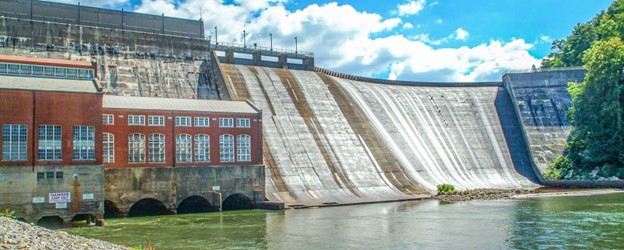Renewable Energy Along the Ocoee
By Kelley Reid
In honor of Energy Awareness Month this October, we are highlighting three historic hydroelectric power facilities owned and operated by the Tennessee Valley Authority (TVA).
The Ocoee River is a well-known destination for whitewater rafting, but the landscape of this river gorge was altered significantly to generate power for industries and control local flooding. Overall, this effort required the construction of three dams along the lower Ocoee in the span of about 30 years. It also required some unique engineering to harness the potential of the river.
The Eastern Tennessee Power Company, later Tennessee Electric Power Company (TEPCO), started this process with the completion of their first dam, Ocoee No. 1, in 1911. This dam is 135 feet high and stretches 840 feet across and led to the formation of Parksville Reservoir. The completion of Ocoee No. 1 was the first of two hydroelectric facilities planned for the Ocoee River by the Eastern Tennessee Power Company.
A few years later in 1913, the company completed its second development, Ocoee No. 2, several miles upriver, which features a dam measuring 30 feet high and 450 feet across. The two facilities were among the earliest hydroelectric plants in Tennessee. Through a network of connecting transmission lines and switching stations, also built by the Eastern Tennessee Power Company, Ocoee Nos. 1 and 2 provided hydroelectric power to Chattanooga, Knoxville, Dalton, Georgia, and to points in between.
In 1939, TVA acquired Ocoee Nos. 1 and 2. This was later followed by its construction of Ocoee No. 3 in 1943 to provide more power for industries in the region that were producing materials needed for World War II. This dam is 110 feet high and 612 feet across and is located roughly two miles upstream from the powerhouse.
Like many conventional dams, Ocoee No. 1 holds a reservoir behind it. This facility produces power by letting water from the reservoir flow through a section of the dam, where it spins turbines connected to the generators located in the powerhouse on site.
Ocoee No. 3 also created a reservoir, but the powerhouse is located about two miles downriver from the dam. Instead of letting water through the dam to begin power production, the water is diverted through a pipeline, which extends about 2.5 miles downhill toward the powerhouse where it connects with the penstock. The water drops 180 feet through the penstock into the powerhouse, where the turbine and generator are housed.
While these dams are each significant, Ocoee No. 2 is unique among the three, and within the TVA system. While Ocoee No. 1 and No. 3 are much larger than Ocoee No. 2, the three dams produce comparable amounts of power. Similar to Ocoee No. 3, Ocoee No. 2 is designed to take advantage of the significant drop in elevation over the roughly 5 mile stretch of river between the dam and the powerhouse. Instead of building a large dam, the engineers designed a 4.7-mile-long wooden flume that would start at the location of the Ocoee No. 2 dam and travel along the cliffs above the river until it reaches the powerhouse. This wooden flume was a significant feat of engineering at the time due to its length and size. The flume only loses 19 feet of elevation by the time it reaches the powerhouse, but the river below loses 270 feet. This means the water flows down into the powerhouse from 250 feet above, creating the momentum to move the turbines. This process gives the 30-foot-high dam the necessary head rate, or potential power, of a dam several times its height.
All three dams are still operating today and are an important part of the TVA system. The employees at these facilities continually express pride in their work with these engineering feats that have had a significant impact in the history of their state.
These three dams are all listed in the National Register of Historic Places, Ocoee No. 1 and No. 2 under the Pre-TVA Hydroelectric Power Development in Tennessee Multiple Property Submission and Ocoee No. 3 under the Tennessee Valley Authority Hydroelectric System, 1933-1979 Multiple Property Submission.